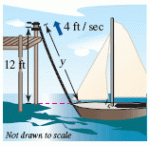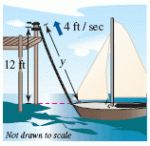Find the acceleration of the specified object. (Hint: Recall that if a variable is changing at a constant rate, its acceleration is zero.)
A boat is pulled into a dock by means of a winch 15 feet above the deck of the boat (see figure). The winch pulls in rope at a rate of 4 feet per second. Find the acceleration of the boat when there is a total of 17 feet of rope out. (Round your answer to three decimal places.)
How to do this??
A boat is pulled into a dock by means of a winch 15 feet above the deck of the boat (see figure). The winch pulls in rope at a rate of 4 feet per second. Find the acceleration of the boat when there is a total of 17 feet of rope out. (Round your answer to three decimal places.)
How to do this??


